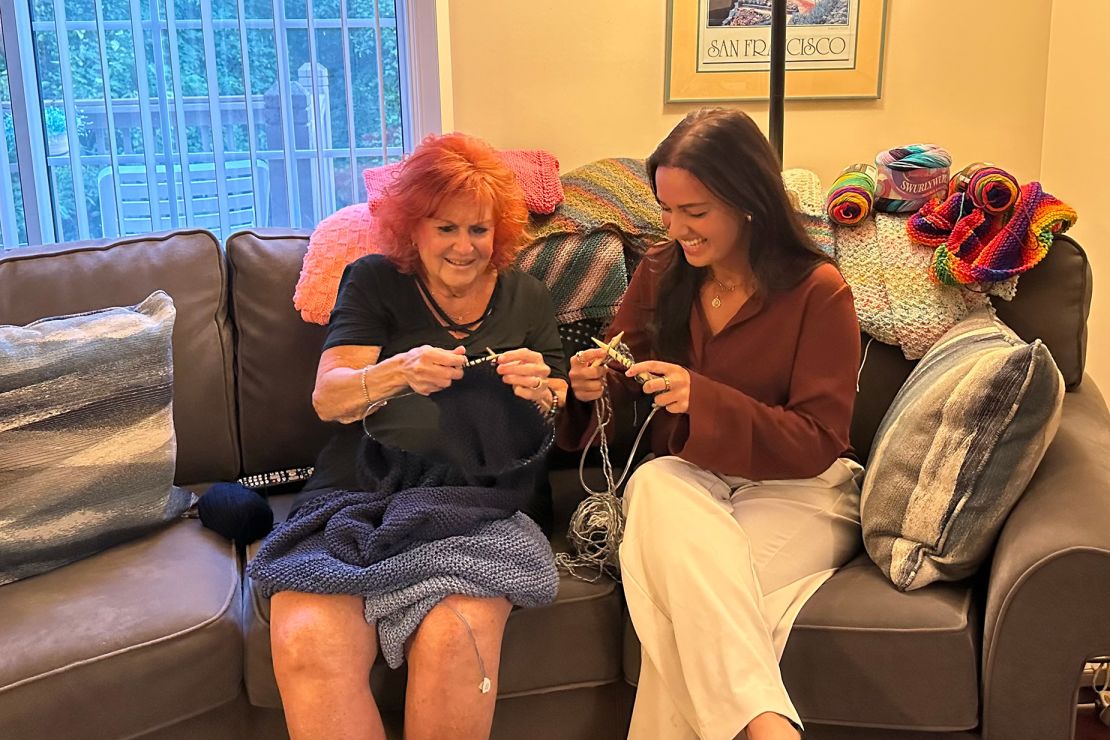Southampton, Pennsylvania
CNN
—
Get inspired with a simple weekly overview of living well. Subscribe to CNN’s Life, But Better newsletter for information and tools designed to improve your well-being
Walking to my grandmother’s house, I watch her hands move quickly as she knits as the stitches stick out from her knitting needles. Next to her are layered stacks of blankets, scarves and ponchos made of woolen yarn in carefully selected colors and patterns. She donates these blankets to children’s hospitals and foster homes.
His favorite pastime is creating. She is always crafting, be it weaving, painting, scraping, or more recently, doing gem art. These activities give him satisfaction and purpose in many ways that are more satisfying than work.
She instilled her love of arts and crafts in the rest of my family. My mother joined community theater groups when she became an empty nester and learned to cast. My younger cousin takes nature photos and his dad (my uncle) has a comedy podcast with voice actors. My twin brother and I sang in college, it kept us sane while balancing our heavy academic workloads.
We thought it would be good for our health, and we were right. Previous studies have shown that creating art reduces the body’s levels of the stress hormone cortisol.

“Dealing in arts and crafts is accessible and affordable. Options such as knitting and drawing require very few tools and can be engaging and creatively rewarding activities,” said Dr. Helen Keyes, cognitive psychologist and head of the School of Psychology and Sport Sciences at Anglia Ruskin University, via email.
Now, a new study by Keyes and colleagues has found that engaging in creative activities can significantly boost well-being by providing meaningful spaces for expression and achievement.
While previous research has shown that creating arts and crafts is therapeutic for people with mental health conditions, the population as a whole has been understudied, according to a recent study published in the journal Frontiers in Public Health.
Therefore, they sampled the population without diagnosed illnesses to see how arts and crafts can contribute to well-being and reduce the effects of loneliness in everyday life.
The team used data from a large national survey conducted in the UK between 2019 and 2020 to examine how creative activities can affect life satisfaction, controlling for variables known to influence well-being such as gender, age group, health, employment and deprivation. The researchers analyzed a sample of 7,182 participants (aged 16 and over) living in England from the UK Department for Culture, Media and Sport’s annual Taking Part survey, which examines how the public gets involved in their activities.
“We analyzed arts and crafts at a broad level, rather than focusing on specific hobbies, because we know that people have different preferences and will find a craft or creative activity that works best for them,” Keyes said.
More than 37% of those who responded to the survey confirmed that they had participated in at least one craft activity during the last year. They were also asked about their employment status, health, sense of worth living, feelings of loneliness, and levels of happiness, anxiety and life satisfaction.
Participant-reported happiness, life satisfaction, and sense of worth in life were positively correlated with participation in arts and crafts, but arts and crafts were not associated with reduced anxiety or loneliness, which warrants further investigation. Further research is needed to explore the social aspects of creativity, the researchers said.
“All forms of art can be beneficial for mental health. Benefits include increased self-esteem, reduced anxiety/stress, improved communication, and enhanced creativity,” Dr. Frank Clark, a psychiatrist and poet at Prisma Health, said by email. Clark was not involved in the study.
Arts and crafts for public health
Scientists argued that arts and crafts could improve public health.
“Governments and national health services could consider funding and promoting crafts, or even social prescribing these activities to at-risk populations, as part of a well-being and mental health promotion and prevention approach,” Keyes said. “Crafting is something that is relatively easy to introduce into your life.”
Craftsmanship provides an opportunity for a sense of achievement and expression through creation.
“A sense of mastery is important to well-being, and crafting and creating art are intrinsically mastery; it means people can see their progress and be proud of what they produce,” Keyes said via email.
If you don’t consider yourself artistic or creative, Clark has four suggestions for tapping into your creative side: Reframe your thinking to be optimistic about your creative potential; don’t be afraid to take risks to try a new activity; foster relationships with people in the creative space that interests you; and think about what you did creatively as a child and do it again.
An inexpensive way to indulge in creativity is painting. While some may perceive coloring as an activity for children, “I love adult coloring books and encourage everyone to embrace their inner child,” Clark said. “Coloring is an example of mindfulness that has many health benefits. It can help promote social connection, improve concentration and stimulate creativity.
And if you are creative, anything can happen. “Creativity has the power to promote resilience, recovery and reconciliation,” she said. “It’s a cathartic antidote that can help give humanity a sense of meaning and purpose.”
#arts #crafts #improves #mental #health #job #researchers #find #CNN